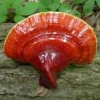Soooooo, what is it? My first reaction was BS also. But these claims are backed up by independent testing and certification sources. Or, is it you think cordyceps in general is bogus? I have some coming but it's not the kind of product whose effects one should notice quickly. I'll report back when I know something more.
Ron
Aloha are not selling extracts, just ground-up powder, but their COA's are without exception showing the specs of an extracted version of their products. They do not guarantee a single active ingredient on the labels of their products. Why?
Aloha's quality claims are not backed up by independent testing. They issue COA's that everybody can produce with access to Wordpad.
Independent third parties such as NAMMEX have retested their Cordyceps and found it to be very low in beta-glucans and very high in starch - a typical result for non-extracted mycelium grown on grain (the undigested grain ends up in the final product). You can contact NAMMEX for details if you want to verify this.
In their homemade COA they are also writing things such as 'modified Megazyme method' as the assay used for their beta-glucan testing.
Megazyme (an Irish lab selling test-kits) has recently forbidden them to use their name any longer, because Aloha's 'testing' makes no sense as the results are unlike what one would get when using the Megazyme method, which has a good rep worldwide.
The only independent COA's they show for some of their products are issued by Atlas Bioscience, a known 'dry-lab' (not actually testing the samples, just ratifying them, which is a dangerous and fraudulent MO). See this article, complete with undercover footage of this lab's owner. Does not help to improve Aloha's credibility, at least IMO.
Their Cordyceps is of a different strain than the one used in the scientific literature. Almost all research so far was done with Cordyceps CS-4, a Chinese mycelium product grown in bioreactors, not on grains. AFAIK it is not produced outside of China. There are ZERO test results for Aloha's Cordyceps, despite their claims of quality and superior raw materials.
I would never buy Aloha's products for all the reasons listed above (summarizing: it is not the well-known and established CS-4, it is not extracted (=low bioavailability) and does not guarantee a single active ingredient on their labels. Furthermore Aloha appears to use deceiving and manipulative marketing methods).
But if it works for you, great!
 CS_Spec_Sheet.pdf 882.36KB
7 downloads
CS_Spec_Sheet.pdf 882.36KB
7 downloads












































